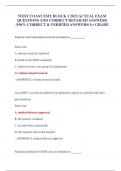Examen
Blueprints Obstetrics & Gynecology, 7th Edition by Tamara Callahan, 9781975134877, Covering Chapters 1-32 | Includes Rationales
- Cours
- Établissement
- Book
Blueprints Obstetrics & Gynecology, 7th Edition by Tamara Callahan, 9781975134877, Covering Chapters 1-32 | Includes Rationales
[Montrer plus]












